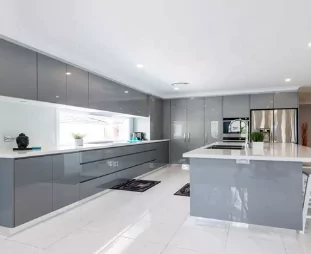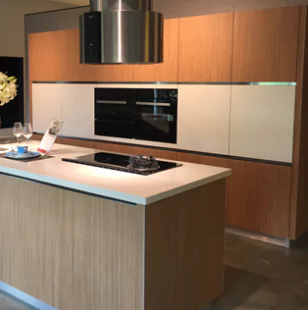Pantry Cabinet Essentials: Your Guide to Optimal Food Storage
 What is a Pantry Cabinet?
What is a Pantry Cabinet?
A pantry cabinet is a specialized storage unit within the kitchen that is used exclusively for food storage. These cabinets can vary in design from sleek modern styles to traditional designs that add character to the kitchen. A well-constructed pantry cabinet not only provides ample space for food items but also includes organizational features such as shelves, racks, and drawers to maximize storage efficiency. They are essential for keeping dry goods, canned foods, snacks, and other essential ingredients at hand and easily accessible. The use of a pantry cabinet helps to reduce clutter, streamline cooking processes, and extend the longevity of food items.
Refor Furniture
About Refor
Refor Furniture specializes in crafting high-quality pantry cabinets that blend functionality with aesthetic appeal. Known for their commitment to durability and style, Refor offers a wide variety of bedroom, laundry room and kitchen solutions tailored to meet individual preferences and needs. Its cabinets are designed using advanced manufacturing techniques and materials, ensuring that they not only look great but also withstand the test of time.
Bespoke Service
Refor provides a bespoke service that allows customers to customize their pantry cabinets according to specific requirements. Whether it’s to fit a unique kitchen layout or to accommodate specific storage needs, Refor‘s experts work closely with clients to create solutions that enhance both the form and function of their kitchen space. Customers can choose from various materials, finishes, and configurations to achieve a cupboard that reflects their style while serving practical purposes.
Customization Process
Whether you’re looking to create a one-of-a-kind piece or simply want to add a personal touch to your space, we’re here to help. We never compromise on quality. Our painting process ensures that your door panels are not only visually stunning but also durable, withstanding the test of time. We confidently guarantee the quality of our door panels for over 10 years, giving you peace of mind and value for your investment.
We understand the importance of seamless delivery. That’s why, regardless of whether you choose flat-pack or assembled shipping, we meticulously assemble and inspect each cabinet before it leaves our facility. This ensures that your custom furniture arrives in perfect condition, ready to enhance your space.
Before your custom furniture leaves our hands, we conduct a thorough quality check and compile a detailed report. This report is then sent directly to you, providing transparency and assurance that your custom pieces meet the highest standards of craftsmanship and precision. Additionally, we offer support throughout the entire process, ensuring that your customization journey is smooth and stress-free.
Storing Fresh Items in the Pantry Cabinet
Airtight Containers for Dry Goods
One of the primary ways to maintain freshness in a pantry cabinet is by using airtight containers for storing dry goods. These containers are designed to protect contents from moisture, air, and pests, thus extending shelf life. When it comes to pantry organization, clear containers can offer additional benefits, allowing you to quickly identify what you have on hand without needing to open each one. Labeling each container ensures easy tracking of expiration dates, helping to prevent food waste and keep your pantry organized.
Shelf Life Extension Techniques
To further optimize food storage in your pantry cabinet, implementing shelf life extension techniques is beneficial. This includes practices such as rotating shelf items regularly, placing newer purchases behind older ones, and keeping perishables at the front of the cabinet for easy access. Additionally, understanding proper storage temperatures and conditions for different types of foods can significantly impact their longevity. For instance, storing certain items in a cool, dry place within your pantry cabinet can help preserve freshness and flavor.

Organizing Your Pantry Cabinet Space
Practical Layouts for Easy Access
Creating a functional pantry cabinet starts with a practical layout that allows for easy access to frequently used items. For instance, positioning the most often reached ingredients at eye level ensures that they are readily available during cooking or meal preparation. Using adjustable shelving can facilitate the optimal arrangement of items, catering to various heights and sizes of packaging. Incorporating pull-out shelves or baskets into the design allows for better visibility and ease of access, extending the usability of the pantry cabinet space.
Moreover, grouping similar items as part of the layout design aids in finding ingredients quickly while minimizing effort. For example, categorizing dry goods, snacks, and canned items into their sections significantly streamlines the cooking process. A thoughtful pantry layout can also alleviate the risk of excess clutter, thus allowing users to maintain an organized and functional kitchen environment. The overall goal is to ensure that every item has its designated spot, enhancing the efficiency of the kitchen workflow.
Labeling Systems to Keep Track of Items
Implementing a labeling system within your pantry cabinet is an effective strategy for maintaining organization and tracking inventory. Clearly labeled containers and shelves provide a visual cue for what is stored where enabling quick retrieval of items. Using a consistent labeling format across the pantry cabinet, such as matching colors or fonts, can create an aesthetically pleasing and streamlined appearance. Consider using both text and images on labels to facilitate easy identification, especially in a household with multiple users.
Additionally, a labeling system can help in managing stock levels effectively. By including expiration dates on labels, you can easily monitor the freshness of items and reduce food waste. Regular checks and updates of labels can further support good inventory practices, ensuring that older items are used before newer stock. An organized and labeled pantry cabinet not only elevates the visual appeal of the space but also enhances the functionality of food storage.
Efficient Use of Pantry Space
Utilization of Vertical Space
Maximizing vertical space within the pantry cabinet is crucial for overall storage efficiency. Tall shelving units reach upwards, facilitating the storage of more items in a compact footprint. This approach not only respects the limited floor space of most kitchens but also allows for creative solutions such as stacking containers or using tiered organizing systems. Adjustable shelving enables users to configure the heights based on personal preferences and the specific storage needs of different items.
In conjunction with vertical storage techniques, incorporating hooks or racks on the pantry cabinet doors can free up additional space for smaller items such as kitchen tools, spices, or light snacks. By thinking vertically and creatively, pantries can become multi-functional spaces that accommodate a wide range of food products and cooking essentials. The judicious use of vertical space in pantry cabinets can significantly enhance both functionality and accessibility.
Innovative Storage Solutions for Small Pantries
In small kitchens, innovative storage solutions are critical to maximizing the capability of pantry cabinets. Utilizing space-saving designs, such as rotating carousels or modular stackable bins, can enhance accessibility and organization in compact spaces. These unique solutions allow for the efficient storage of items without sacrificing usability or aesthetics. Implementing sliding shelves or compartments can create additional visibility, ensuring that all items are easily reachable without needing to dig through clutter.
Additionally, magnetic strips installed on pantry cabinet walls can be used to hold small metal containers that store spices or cooking tools, further utilizing often-overlooked areas. The use of transparent bins also aids in maintaining organization while allowing users to visually assess what they have on hand without needing to open each container. With innovative approaches to pantry organization, users can transform even the smallest of pantry cabinets into practical and orderly spaces, facilitating seamless meal preparation and food storage.
A well-organized pantry cabinet is not just about storing food; it is a critical aspect of an efficient and pleasant cooking experience. By considering practical layouts, effective labeling systems, and innovative space-saving solutions, users can create a kitchen environment that truly enhances their culinary endeavors. Embracing these aspects can lead to a more enjoyable cooking experience while maintaining professional standards of organization and efficiency in food storage.

